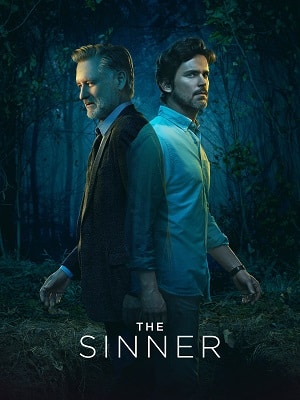TV Review
The Sinner
Nestled among a sea of crime procedurals with their color-by-number murder investigations, “The Sinner” on USA Network stands out with a refreshing twist. It’s not about “whodunit”; it’s all about “whydunit.” However, for fans of the show who are making their way through the series, a word to the wise: the books by Petra Hammesfahr don’t quite mirror the television adaptation. Yet, this divergence is not a detractor, but rather a delightful detour.
“The Sinner” catapults us headfirst into the all-consuming question of motive, bypassing the tedious tick-tock of conventional crime dramas. The fundamental structure of the series is unique: it starts with the revelation of the perpetrator from the get-go, turning the typical whodunit narrative on its head. Instead, the series navigates the murky waters of psychology, trauma, and human nature in its quest for the ever-elusive ‘why.’
If ever there was an actor capable of anchoring such a maelstrom of internal chaos, it’s Jessica Biel. Her portrayal of Cora Tannetti in Season 1 is raw and compelling. Biel embodies a character tangled in a web of repressed memories and pain, forcing us to grapple with her palpable sense of anguish. She is the first ‘sinner,’ a woman whose shocking and public act of violence sets the tone for the series.
The show’s casting is a vital cog in the mechanics of the series. Bill Pullman’s Detective Harry Ambrose is a complex, deeply flawed character, who is as intriguing as the cases he investigates. Pullman imbues Ambrose with an almost abrasive authenticity. It’s hard not to become deeply invested in his personal journey, fraught with past demons and unconventional coping mechanisms.
In contrast to the TV adaptation, the original novels offer a darker, more intense exploration of the characters’ psyches. While the show explores the protagonist’s journey through crime and punishment, Hammesfahr’s novels navigate a more profound abyss of human nature and moral decay.
The television series, under Derek Simonds’ deft guidance, succeeds in repurposing the books’ DNA while diverging significantly from the source material. Simonds smartly streamlines the novels’ complex narrative, transposing the dense, dark tapestry of the books into an accessible, albeit still intriguing, format for television.
An excellent example is in the transition from the second book to Season 2. The source material, “The Case of Annie B” by Hammesfahr, serves as an inspiration rather than a blueprint. Here we find a wholly new crime and an utterly different ‘sinner,’ Julian. Elisha Henig gives a chilling performance as the troubled young boy, imbuing the character with a nuanced blend of vulnerability and latent malevolence.
The third season takes an even more dramatic departure from the books. It eschews the female ‘sinner’ motif of the first two seasons and Hammesfahr’s novels. Instead, it opts for an exploration of the male psyche, focusing on Jamie Burns (Matt Bomer), an expectant father grappling with an existential crisis. The narrative shift marks a new direction for the series, allowing the exploration of more diverse themes and characters.
“The Sinner” has a knack for leaving viewers teetering on the edge of a rabbit hole, only to push them in at the last minute. It’s a journey into the depths of human psychology, artfully brought to life through compelling performances and insightful writing. It continually asks its audience: why do ordinary people commit heinous acts?
This divergence from the books might initially ruffle the feathers of Hammesfahr’s most ardent fans. However, the series’ creative decision to not just reproduce the novels faithfully, but to capture their essence and adapt it into an engaging narrative, arguably adds more value.
One of the elements where the show truly shines is its ability to humanize villains, a trait it inherits from Hammesfahr’s novels. It paints a picture where ‘evil’ is not a demonic entity but an outcome of personal history, environment, and at times, an array of bad decisions. It challenges the viewer to empathize with the perpetrators, a journey that is as unsettling as it is thought-provoking.
Visually, the series is an engaging exploration of color and contrast. The stark, haunting cinematography of upstate New York pairs well with the narrative’s deep dive into the characters’ darkest recesses. The setting becomes a character in its own right, echoing the turbulence and turmoil lurking beneath the surface of these seemingly mundane towns.
The show, much like the books, is a masterclass in the art of slow-burning suspense. Each season peels back the layers of its central mystery with a measured pace that requires — and rewards — patience. Instead of relying on flashy gimmicks or shocking twists, “The Sinner” invests in carefully crafted character development, ensuring that the eventual revelation feels both surprising and satisfying.
The sound design deserves special mention as well, with an atmospheric score that adds another layer of complexity to the narrative. From the eerie opening theme to the tense background scores, the music plays a crucial role in heightening the suspense, often acting as the proverbial heartbeat of the series.
“The Sinner” is not a show for those seeking the comfortable predictability of standard crime drama fare. It delves into a kind of darkness that’s disturbing yet captivating, full of rich character studies and unpredictable narratives. While it deviates significantly from Petra Hammesfahr’s novels, it carries the torch of their spirit — asking uncomfortable questions about human nature, guilt, and redemption.
To say that “The Sinner” is just another crime drama would be doing it a disservice. It’s a profound exploration of the human psyche that takes you on a journey you may not entirely be ready for but will definitely remember. As for the divergence from the books, well, all I can say is, “Vive la différence!”







